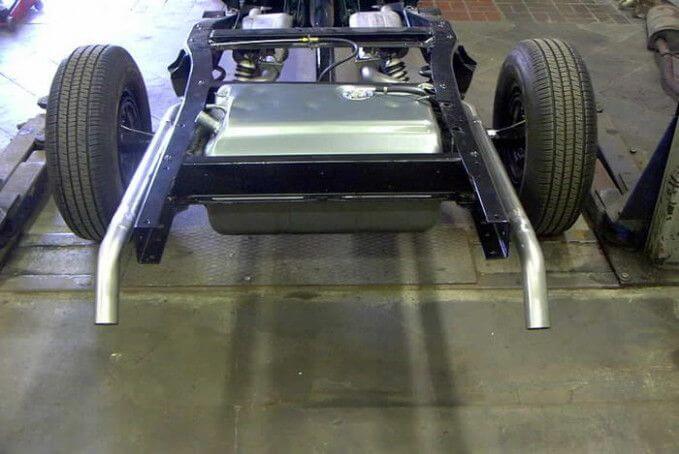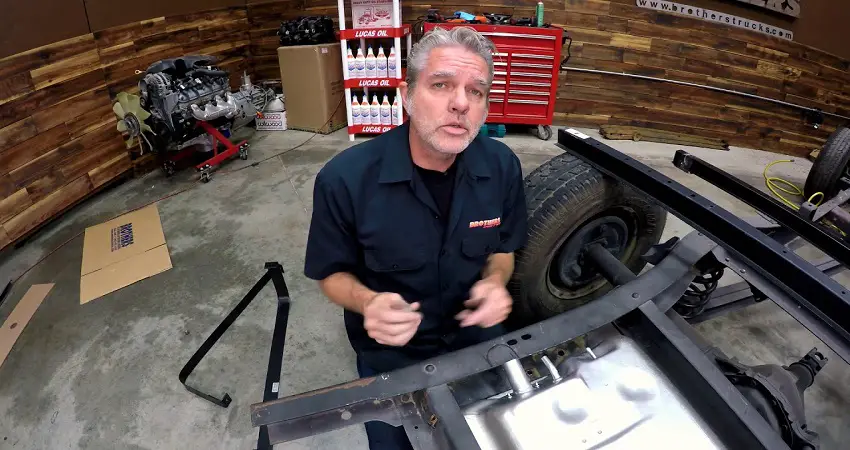Last Updated on November 27, 2023 by John Robinson
A classic pickup truck like a 67-71 Chevy would perform at its absolute best if the original suspension is intact and there is load in the rear. This is essential because most pickup trucks are designed to carry ample load in the back. The addition of extra weight makes the front-to-rear weight distribution close to the ideal half and half balance.
You’ll notice better traction under acceleration. And if the truck is not overloaded, your stops would be mesmerizing. A heavy truck such as a 67-72 Chevy would require an adequate redistribution of weight to keep the rides balanced. It is almost necessary for every 67-72 Chevy to be equipped with a custom made rear mount gas tank.
The General Motors 21-gallon gas tank is most commonly utilized for this procedure. One benefit of this purchase would be the easy availability of any additional accessories. Rest assured that this alteration would also boost your truck’s fuel economy
Note that rear mount gas tanks are commonly found in vintage trucks because of the better weight distribution. It also eliminates the smell of the gas out of the cab. This arrangement might interfere with the positioning of the spare tire in modern-day trucks.
Know How to Adequately Install a 67-72 Chevy Truck Rear Mount Gas Tank

-
Determine the right tank size
Your first step would be to determine what size of the tank would fit your truck. You could utilize some reproduction optional auxiliary tank or a universal tank that suits your needs. The General Motors 21-gallon tanks are generally recommended. Otherwise, you could get any good quality gas tank with at least 14-gallon capacity.
You can also browse our range of Titan tanks here. Find the right size of fuel tank you need that doesn’t delaminate and get corroded by biodiesel. These tanks also don’t have welds and condensation problems. They are quieter and lighter than metal tanks.
-
Utilize adequate mounting straps
You could either use universal mounting straps or the stronger steel straps. For the success of this arrangement, you’d have to correctly determine the height at which the tank should be mounted in the frame of the truck. The straps would then be bent accordingly.
If you take the bed off the truck, the installation of the gas tank would become more convenient. Although, it is definitely possible to complete this installation with the bed on. In case you decide to take the bed off, carefully measure the height of the bed’s cross sill and see how much space would be left above the tank.
-
Take accurate measurements
Once you have taken all the necessary measurements, you can support the gas tank with the help of a floor jack at the selected position and measure the necessary dimensions for the mounting straps. These mounting straps must appropriately support the tank between the two rear cross members of the chassis. You can get crisp bends made in the mounting straps through a trained mechanic. You wouldn’t want unclean bends that fail to perfectly support your gas tank.
It is fair to carefully check your measurements by mounting the straps between the two cross members in your garage and watching their alignment with respect to the grooves of your tank. After the tank is set in place, check your measurements again.
Once this is done, check the measurements for the ⅜” mounting bolts that would be center-punched on the forward and rearward ends of the mounting straps. It is recommended that you leave extra lengths of the mounting straps at the ends so that they can be trimmed accordingly.
-
Carefully secure the gas tank
While it is not possible for the gas tank to jump off with the bouncing of your trunk, it is still recommended that you add a top strap that secures each mounting strap above the gas tank. This would reduce the vertical movements of the gas tank. This attachment is fairly important since the gas tank is not physically attached to the mounting straps.
-
Trim the extra mounting straps
Before you trim the mounting straps, it is suggested that you mount the roll-over vent valve in a vertical orientation above the tank. The roll over vent valve is connected to the tank with the help of a rubber fuel hose.
-
Mount the fuel pump

You’d need to again locate the pre-existing fuel pump that lies close to the new gas tank. Typically, a fuel pump is mounted vertically for the best performance. This type of mounting would ensure that the inlet and outlet are lower than the lowest portion of the tank.
You can easily fabricate an additional bracket to mount the fuel pump in a proper position. Note that the fuel pump gets adequate protection through a rear axle housing and the fuel tank. This position would grant it adequate safety in a truck that only navigates paved roads.
But if your truck goes off-roading, this position may lead to a little concern. However, such problems haven’t been noticed with trucks that are taken off-roading. Once the gas tank and the electric fuel pump have been securely and adequately mounted, it is suggested that you route the fuel line.
-
Route the fuel line
Your ideal fuel line must consist of ⅜” rubber fuel hose and ⅜” steel hard line. Note that this setup doesn’t include a return line. You can utilize a section of the rubber hose to connect the outlet of the electric fuel pump to the hard-line. Another short section of rubber hose can be used to connect the inline fuel filter and the carburetor.
You must keep your fuel line from vibrating or chafing. A steel hard line can be firmly clamped at one place through rubber-coated line clamps set at different positions. Make sure that you have carefully secured the filler neck and the fuel level sender. When all is done, you can get rid of the original tank and cover the filler hole.
Are rear-mounted gas tanks safe?

The worst auto crash fire defect in the history of the US Department of Transportation was reported with the General Motors built pickup trucks. These vehicles frequently got involved in fire crashes and over 2000 people were killed in such eventualities over 1973 through 2009. Earlier, gas tanks were always located inside the pickup trucks.
It was speculated that the presence of the gas tank inside the passenger cab could lead to safety hazards. This was when Ford, GM, and Chrysler considered relocating the tank outside of the passenger compartment. Chrysler has then realized that placing the tank outside the frame would be easily be encroached upon in the eventuality of a crash. The probability of a tank leakage in such an instance would be too high.
It was then suggested that the fuel tanks be mounted outside the cab but nearer to the center of the vehicle. GM even installed shields around the gas tanks to prevent them from leakage in a mishap.
It was then discovered by GM that the rear located and the inside the frame fuel tanks were both superior to the tanks that were positioned outside the frame. However, it was later realized that no amount of protection could ensure that a gas tank outside of the frame wouldn’t leak in case of a collision.
Note that rear mount fuel tanks cannot be considered safe because if your truck gets hit at the rear-end, a leakage in the fuel tank could result in a deadly fire and even an explosion.
Consider the advantages of a rear mount fuel tank
The relocation of the gas tank to the rear-end moves the weight of the fuel to a rather optimal location. The perfect weight balance is created for your heavy 67-72 Chevy truck.
The interior room of your vehicle is freed and there remains no chance of gas fumes inside the cab.
The galvanized steel construction of gas tanks makes them a perfect fit for wood and steel bed trucks.
Conclusion
You may require certain additional parts to complete the installation. This would include a gas filler neck, filler hose, and a gas cap. You’d also need to relocate the frame-mounted spare tire on your 67-72 Chevy truck. The removal of the spare tire is necessary because it interferes with the proper positioning of the fuel tank.
Overall, the performance of your truck is definitely going to improve with this relocation. You are certainly gonna gain fuel mileage after the creation of that perfect balance in your heavy truck. Note that pickup trucks are built with the assumption that they’d spend most of the time carrying loads in the rear.
In case that demand isn’t fulfilled directly, it can definitely do well with some extra weight. Yoru stops will get better and your truck will behave tremendously better under acceleration. Although, you must also consider the safety standards that a rear-mounted gas tank is meted with.
Consider that a rear mount gas tank will be directly hit in case of a collision and may also suffer a leakage. This increases the possibility of crash fires and explosions. While rear mount gas tanks might benefit your truck in many ways, your safety is not amongst the pros.
[su_youtube url=”https://youtu.be/jHnu2eqdypg” width=”800″ height=”460″]


